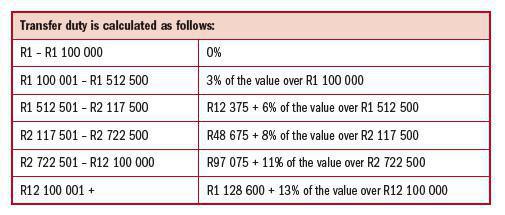Transfer duty is an indirect tax on the acquisition of immovable property situated in South
Africa. The following are the main provisions:
- It is calculated on the value of the immovable property (purchase price or market value whichever is the highest).
- It is payable within six months after the transaction is entered into.
- Where a registered VAT vendor purchases property from a non-vendor, the notional input tax is calculated by multiplying the tax fraction [15/115 (14/114 before 1 April 2018)] by the lesser of the consideration paid or market value.
- The acquisition of a contingent right in a trust that holds a residential property or the shares in a company or the member’s interest in a close corporation which owns residential property comprising more than 50% of its assets, is subject to transfer duty at the applicable rate.
The most notable exemptions from transfer duty are the following:
- If the purchase price/value is R1 000 000 or less.
- If the transaction is subject to VAT (i.e. where the seller is a VAT vendor).
- In the event of immovable property being transferred to a person (including a close corporation, company or trust), in terms of a Last Will and Testament, or as a result of intestate succession.
- The transfer of any property to a surviving spouse, or divorced person, who acquires sole ownership of the whole or any portion of property registered in the name of his or her deceased or divorced spouse where that property or portion is transferred to that surviving or divorced spouse as a result of the death of his or her spouse or dissolution of the marriage or union.


